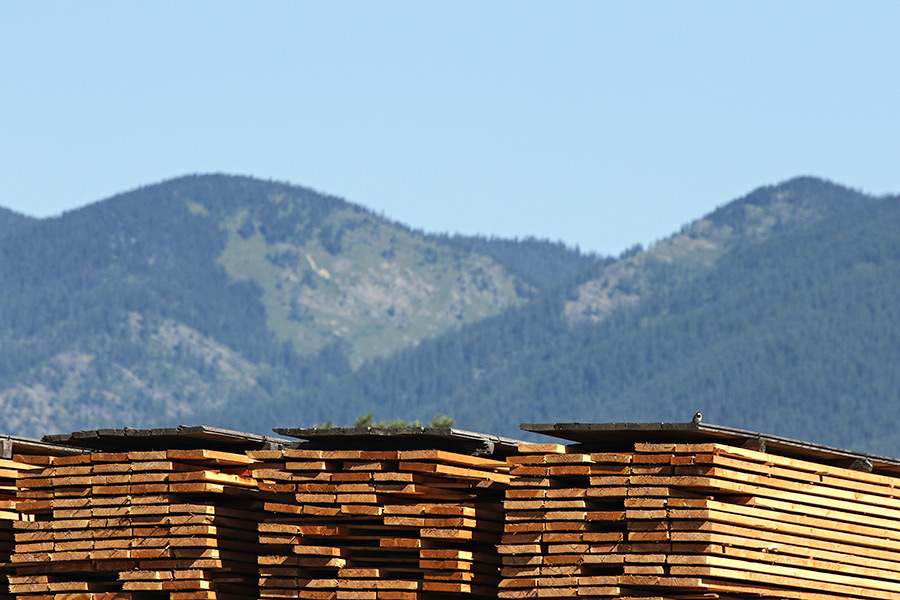The U.S. and Canadian governments are approaching the end of a one-year standstill that could erupt into a trade dispute over timber imports that industry officials and federal lawmakers say are hurting Montana mills.
Trade representatives from both countries have until midnight, Oct. 12 to reach a new deal before industry leaders can file complaints in court against Canada.
The U.S. timber industry says Canadian producers are benefiting from an unfair cost advantage by exporting subsidized softwood products that are undercutting U.S. producers. Canada is one of the world’s largest producers and exporters of softwood lumber, which is used to build homes, and the U.S. is the largest market for Canada’s softwood products.
A nine-year softwood lumber agreement between the two countries expired in October 2015 followed by a one-year grace period to allow both sides to negotiate a new deal before any trade complaints could be initiated.
Barring an 11th-hour deal, it appears the two countries are headed for a trade battle that could include new tariffs on Canadian lumber imports.
“If we cannot have an agreement that works, then obviously we would have no choice but to initiate trade cases,” Zoltan van Heyningen, executive director of the U.S. Lumber Coalition, a Washington, D.C.-based alliance of U.S. timber producers, told the Beacon on Oct. 11.
“From our perspective, it looks like we’ll have no choice but to file cases. In doing so, we’re simply doing what we have to do.”
Since the trade agreement expired a year ago, the market share of Canadian softwood in the U.S. has jumped from 20 percent to 30 percent, according to van Heyningen. According to Statistics Canada, the country’s softwood lumber exports to the U.S. were $3.2 billion after the first seven months of 2016.
“We’ve seen quite a spike in the Canadian market share, which means a spike in Canadian products into the U.S. That’s had a negative effect on our industry,” van Heyningen said.
Paul R. McKenzie, president of the Montana Wood Products Association and lands and resource manager at F.H. Stoltze Land & Lumber in Columbia Falls, said he appreciates the efforts of the Montana congressional delegation and U.S. trade negotiators who tried to secure a new agreement.
“Canadian lumber imports continue to seriously harm Montana lumber companies, workers, and their communities,” McKenzie said. “This is why we need an agreement that is effective and sustainable. Alternatively, we need our government to fully enforce the U.S. trade laws against unfair Canadian trade practices.”
Montana’s congressional delegation worked with trade representatives in recent years to try and work out a deal, and in June, President Obama met with Prime Minister Justin Trudeau and agreed on a joint framework that would keep the Canadian market share at or below a certain level. Yet since then negotiations have stalled and Canada has not engaged with U.S. trade reps to make any progress, according to the U.S. Lumber Coalition.
“Subsidized and unfairly traded lumber imports continue to severely harm Montana mills, workers and communities,” Montana Sen. Steve Daines said Tuesday. “Seven months ago, President Obama and Prime Minister Trudeau committed to find a new framework and we need USTR to aggressively fight for U.S. jobs. If a new, fair deal cannot be reached, it may be necessary to pursue other options.”
This summer Daines and fellow Montana U.S. Sen. Jon Tester jointly issued a letter to U.S. Trade Ambassador Michael Froman pushing for a new agreement that would include volume restrictions, which would provide a competitive market for American lumber.
“Montana is waiting for a new softwood lumber agreement that will support jobs and our state’s timber industry,” Tester told the Beacon on Oct. 11. “Unfortunately, Canada hasn’t stepped up like we had hoped. But looking back isn’t going to get us anywhere, that’s why I will continue to push for a new agreement so Montana’s timber industry is treated fairly in the global marketplace.”
Last month, Montana U.S. Rep. Ryan Zinke similarly joined a bipartisan letter urging negotiations to move forward in hopes of finding a solution that ensured U.S. producers have fair competition.
The issue revolves around Canada’s unique relationship with its timber industry and its largest trade partner, the United States. While most timberlands in the U.S. are privately owned, the Canada provincial governments own a majority of their country’s timberlands. U.S. producers say the playing field is not level because the Canadian government can give cheap timber to its country’s producers, allowing them to outcompete U.S. producers, whose industry prices are determined by market factors.
“This comes down to a jobs issue. It’s basically are we going to allow Canadian subsidies to substitute Canadian jobs with our jobs?” van Heyningen said.
“Will we allow our jobs to go away because they have a subsidy system? Our view is that we should be able to compete on a level playing field that doesn’t cause our jobs to be lost with unfair trade.”
The potential trade complaints could result in the U.S. Department of Commerce imposing so-called preliminary duties on Canadian lumber, which would increase costs for producers up north. After the 1996 lumber deal expired, the U.S. government imposed a 32 percent export duty. It was reduced to 27 percent in 2002 and remained in effect until a new agreement was reached in 2006.
